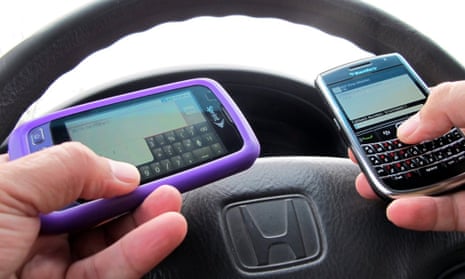America’s roads are getting more dangerous than ever as drivers text, tweet, take selfies and even video chat, according to a new poll by AT&T.
The telecoms company has commissioned research from the data firm Braun, which found that not only do 60% of drivers admit to texting behind the wheel, 33% work on email, 10% video chat, 14% use Instagram and 28% surf the internet.
AT&T conducted a poll of more than 2,000 people aged 16 to 65 who drive at least once a day. It’s all part of the company’s It Can Wait PSA campaign, aimed at reducing accidents related to internet access, which the company provides.
The survey also found that there were some people who kept their attention divided regularly while they drove – 30% of the people who used Twitter while in motion said they did it “all the time”. More than a quarter of the people who shoot photos while driving said they believed they could do it “safely”. (A search for the phrase “driving selfie” on Twitter appears to support those findings.)
mom is taking a selfie while driving are you kidding me safETY FIRST PLS pic.twitter.com/wAXhwQ1CH6
— cheyenne corbine (@cheymc17) May 7, 2015
Given that a number of people who check social media while driving cited “addiction” as a reason, there’s now an app for that. AT&T’s DriveMode application silences message alerts and responds to texts and chats with custom away messages letting whoever is on the other end know you’re otherwise engaged.
Part of the problem with getting users to log off long enough to save their lives is neurochemistry: authors at the Psychology Today have used the phrase “dopamine loop” to describe the addictive feedback we get from texting, tweeting, and liking each other’s vacation snaps. “If there is a small, specific cue that signifies that something is going to happen, that sets off our dopamine system”, wrote Dr Susan Weinschenk in a post published last year. “So when there is a sound when a text message or email arrives, or a visual cue, that enhances the addictive effect.”
“When you receive a text or when you receive a light or the ding of a tweet, your body actually releases dopamine, the same as if you are eating chocolate or having sex or doing cocaine,” said Peter Shankman, a consultant who has worked on marketing, social media and PR for companies from Nasa to Disney. “Not as much! But they’re the same chemicals.”
Shankman suggested that the users won’t necessarily stop doing this sort of thing, and hardware manufacturers can’t reasonably shut off the phones of everyone in a car. “Every time you rent a car and get a GPS you have to push a button saying ‘I will not use this while driving’, and that’s there solely to keep Hertz from getting sued,” Shankman pointed out.
But he said he believes the high will wear off in a few years – these young technologies, he said, will be less enticing to kids who grow up with them.
Is this a sign of a culture’s consummate narcissism, though? “Do you know how long it took a king to sit for a portrait in the 1400s?” Shankman asked. “It could take 15 days!”

Comments (…)
Sign in or create your Guardian account to join the discussion